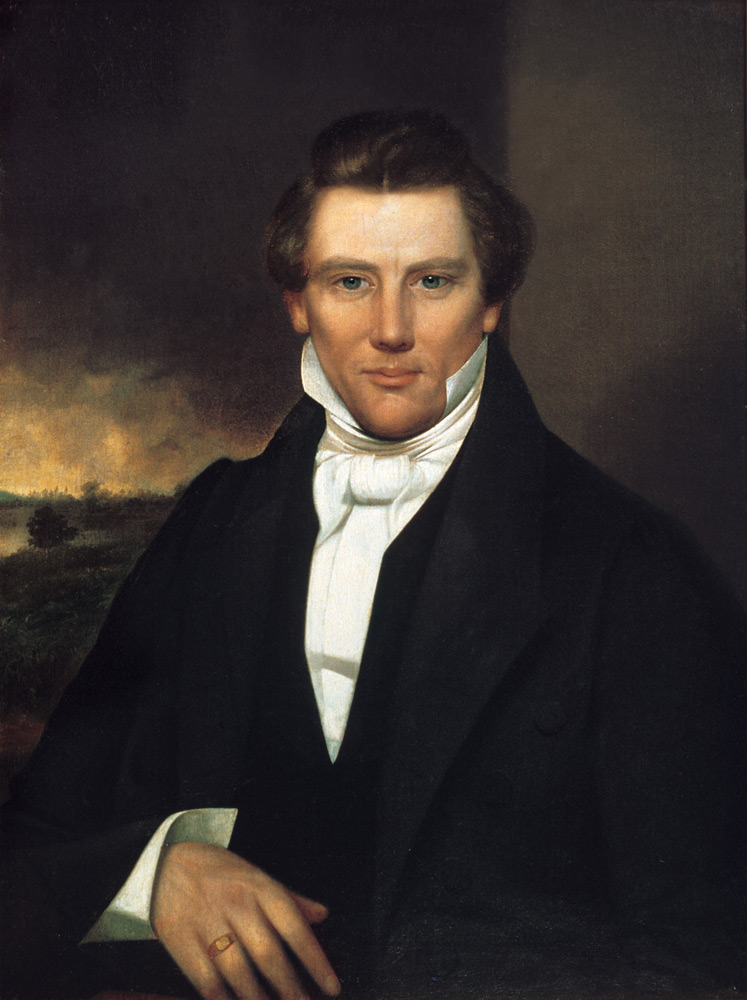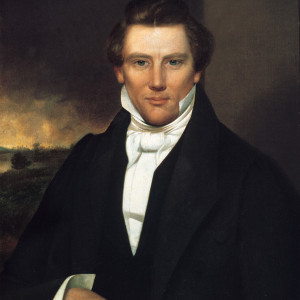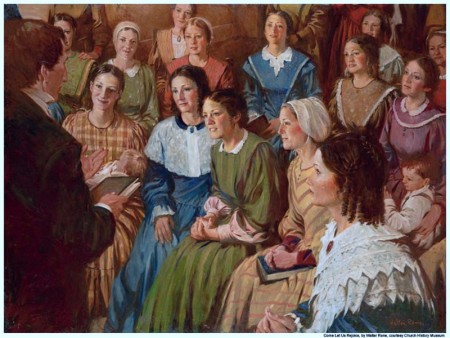Brent Stubbs (who has an amazing Catholic blog of his own) passed along this post to me. In it, Doug Gibson makes a pretty bold claim: that “decanonization” has occurred in the Mormon scriptures. That is, texts which were once declared to be inspired Scripture were later declared not Scripture and simply discarded. I did a bit of research, and discovered that Gibson was right. This has happened twice: with the Lectures on Faith, and with Doctrines & Covenants 101.
The “Lectures on Faith” were a series of seven lectures once included in Doctrines and Covenants. They were included as the first part of the 1835 edition of Doctrines & Covenants, with this introduction:
The second part contains items or principles for the regulation of the church, as taken from the revelations which have been given since its organization, as well as from former ones.
But in 1921, the Lectures were removed. Now, some Mormons claim that the Lectures were never understood to be Scripture. Given the prominent role that they played in the 1835 edition of the D&C, and the fact that they weren’t demarcated as non-canonical, I don’t find this claim very compelling.
 |
| Joseph Smith |
But in either case, there’s a bigger problem. Whether understood as Scripture or not, Lecture 5 contains a view of the Mormon Godhead that’s inconsistent with later Mormon views. Richard S. Van Wagoner, Steven C. Walker and Allen D. Roberts have a fascinating article in a Mormon theological journal (Dialogue) about the Lectures, in which they note that Joseph Smith endorsed, and helped prepare them for inclusion in the D&C:
Whatever Joseph Smith’s original position, he noted his involvement in preparing the Lectures for publication: “During the month of January [1835],” his official journal records, “I was engaged in the school of the Elders, and in preparing the lectures on theology for publication in the book of Doctrines and Covenants” (HC 2:180). He underscored his personal support of the Lectures by noting the introduction to the 1835 edition that he accepted responsibility for “every principle advanced.”
Even the Mormon apologetics group FAIR concedes, “Recent authorship studies ascribe the wording of the lectures “mainly to Sidney Rigdon,” with Joseph Smith substantially involved, and others perhaps having some influence.”
So given this, and the prominent endorsement in the Introduction to the 1835 edition, consider what Lecture 5 says about the Godhead. In the lecture itself, we’re told:
There are two personages who constitute the great, matchless, governing, and supreme power over all things – by whom all things were created and made that are created and made, whether visible or invisible; whether in heaven, on earth, or in the earth, under the earth, or throughout the immensity of space. They are the Father and the Son: The Father being a personage of spirit, glory, and power, possessing all perfection and fullness. The Son, who was in the bosom of the Father, a personage of tabernacle, made or fashioned like unto man, or being in the form and likeness of man – or rather, man was formed after his likeness and in his image.
So the Godhead consists of two Persons: the Father and the Son. The Holy Spirit isn’t a separate Person, but is simply the common Mind of the Father and the Son. And while the Son is in the form of Man, the Father is a “personage of spirit.” This was reaffirmed with some questions and answers at the end of the lecture:
Q. How many personages are there in the Godhead?
A. Two: the Father and the Son (Lecture 5:1).
Q. How do you prove that there are two personages in the Godhead?
A. a. By the Scriptures: Gen. 1:27 (Inspired Version)†; (also Lecture 2:6); “And I, God, said unto mine Only Begotten, which was with me from the beginning, Let us make man in our image, after our likeness; and it was so.”
b. Gen. 3:28 (Inspired Version)†, “And I, the Lord God, said unto mine Only Begotten, Behold, the man is become as one of us, to know good and evil.”
c. John 17:5, “And now, O Father, glorify thou me with thine own self with the glory which I had with thee before the world was” (Lecture 5:2).
All of that is pretty clear. But contrast it with what Mormonism teaches today, from D&C 130:22,
The Father has a body of flesh and bones as tangible as man’s; the Son also; but the Holy Ghost has not a body of flesh and bones, but is a personage of Spirit. Were it not so, the Holy Ghost could not ddwell in us.
- There are now Three Members of the Godhead, not Two;
- The Holy Spirit is no longer the common Mind of the Father and Son, but a Personage of Spirit;
- The Father is no longer a Personage of Spirit, but now has a Body, just like the Son.
There are two texts known as Doctrines & Covenants 101. The first of these was promulgated in 1835, and is available here and here. It contains an important statement denouncing polygamy:
Inasmuch as this church of Christ has been reproached with the crime of fornication, and polygamy: we declare that we believe, that one man should have one wife; and one woman, but one husband, except in case of death, when either is at liberty to marry again.
 |
| Emma Smith |
Unlike Lectures on the Faith, there’s no question that this was removed from the canon, and disregard. The reason is that the Mormon view on polygamy reversed (twice, actually). Doctrines & Covenants 132:4 declared “a new and an everlasting covenant; and if ye abide not that covenant, then are ye damned.” This new revelation called for (and in some cases commanded) polygamy, and included a threat against Joseph Smith’s wife Emma if she didn’t accept Joseph’s other wives, she’d be destroyed (D&C 132:52). In relevant part, it teaches (D&C 132:61-62):
And again, as pertaining to the law of the priesthood—if any man espouse a virgin, and desire to espouse another, and the first give her consent, and if he espouse the second, and they are virgins, and have vowed to no other man, then is he justified; he cannot commit adultery for they are given unto him; for he cannot commit adultery with that that belongeth unto him and to no one else.And if he have ten virgins given unto him by this law, he cannot commit adultery, for they belong to him, and they are given unto him; therefore is he justified.
This new and “everlasting ” covenant was more or less set aside in Official Declaration 1 in 1890, which falsely claimed:
We are not teaching polygamy or plural marriage, nor permitting any person to enter into its practice, and I deny that either forty or any other number of plural marriages have during that period been solemnized in our Temples or in any other place in the Territory.
This gets more interesting when you see the headnotes provided by the LDS Church, which say of D&C 132 (the revelation permitting polygamy):
Although the revelation was recorded in 1843, it is evident from the historical records that the doctrines and principles involved in this revelation had been known by the Prophet since 1831.
In other words, even though he didn’t claim to receive a revelation that okayed polygamy until 1843, he’d been living like he’d received such a revelation since 1831. That strikes me as the most polite way I’ve ever heard of describing someone as an adulterer. And indeed, the historical record is clear that Joseph Smith was marrying women besides Emma back in the early 1830s.
But hold on a second. If “the Prophet” was living according to the not-yet-announced rules about plural marriage back in 1831, how can we account for the 1835 version of Doctrines & Covenants 101 declaring on behalf of “this church of Christ” that “one man should have one wife; and one woman, but one husband, except in case of death, when either is at liberty to marry again,” and feigning disgust at being “reproached with the crime of fornication, and polygamy”?
It’s strange enough that the Church of Jesus Christ of Latter-Day Saints has now twice de-canonized Scripture. But stranger still is that official Church teachings on things like the nature of God, and on Christian marriage have gone in all different directions: that is, that in jettisoning Scriptures, they also jettisoned an old set of beliefs. I’d pose the following questions to any Mormons reading this:
- Are there any other sections of LDS Scripture that are considered inspired today, that might be jettisoned to the ash heap of history tomorrow? How can we know?
- Was Lectures on Faith the word of God?
- Was Doctrines & Covenants 101 the word of God?
- Were Smith and the Church in error in promulgating Lectures on Faith and D&C 101?
- Were Smith and the Church in error in rejecting Lectures on Faith and D&C 101?
- Did the truth of the nature of the Godhead change between the 1830s and 1840s?
- Was plural marriage moral or immoral in 1835?



I hope this helps Mormans.
Same thing happened to me when I left the PCUSA. In their catechism (The Book of Confessions), the Second Helvidic Confession refers to Mary as “ever virgin” which NOBODY at PCUSA believes today. Crazy.
Actually, I would say both of those de-canonizations are actually still alluded to elsewhere in LDS literature. In other words, even though the chapters were dropped, there is evidence that the doctrines were retained.
(1) The Holy Spirit is an anomaly/appendage in LDS thought. The biggest problem I’ve been told from ex-Mormons (now Catholics) is that the Holy Spirit doesn’t fit their concept of godhood, because He has no body and thus cannot be glorified. A spirit person resulting from sexual relations in heaven still needs to attain a human body. The height of glory/deification in Mormonism is for a human body to ‘progress’ up to godhood, including having children via sexual relations (as God “the Father” of this planet has done), yet this is impossible for the Holy Spirit. This low view of the Spirit is still alluded to even today. For example, the Holy Spirit is not really mentioned in much in early LDS work, particularly in Joseph’s visions (which you posted a picture of, showing only Father and Son).
(2) You wrote an excellent article a while back showing there is a blatant contradiction in the Book of Mormon saying Polygamy is a Sin in one place but saying it is OK in another. This indicates that even though the polygamy section was de-canonized, there are allusions to the fact this was at a time important dogma.
Lastly, it cannot be understated the level of authority Joseph Smith had when teaching. For the LDS, is unacceptable to suggest Joseph Smith ever erred even as a ‘private theologian’. Such a distinction doesn’t exist as it does with the Pope. For Mormons, Smith was flawless in everything – they can never concede something he taught was error, even if it isn’t LDS scripture.
To start off, I’ve never met an angry Mormon. They’re all a bunch of nice, wholesome, nice, decent, and nice folk… I have respect for one who is willing to go off to the farthest reaches of the globe to introduce people to Jesus Christ. That being said…
Their theology is the equivalent of early 19th century science fiction.
Their linguistic claims are equally ludicrous. “Reformed Egyptian” is not a language! It doesn’t match any written script anywhere, at any time! As an amateur-linguist I can tell you that the Voynich Manuscript makes more sense than “Reformed Egyptian”!
An interesting piece of work about this topic is “The Burned-Over District”
http://www.amazon.com/Burned-over-District-Intellectual-Enthusiastic-1800-1850/dp/0801492327/ref=sr_1_1?ie=UTF8&qid=1324080416&sr=8-1
and
http://en.wikipedia.org/wiki/Burned-over_district
It’s fascinating how all of these religious movements grew out of this tiny little patch of land in New York state.
I’ve often joked with my dad that in about 150 years or so we’ll be seeing a bunch of Scientologists walking around in suits and ties, well-groomed, and preaching pro-life/ conservative viewpoints like Mormons do today.
And to finish off here’s a hilarious video of the song “I Believe” from the Broadway Show “The Book of Mormon”
http://www.youtube.com/watch?v=PHEqCXY2B-w
The “De-Canonizing” of Scripture is the least of LDS’ theological worries.
This article confirms for me that the mormons are in the same category as so many other sects. Theirs, like TEC, is a pick-and-choose religion.
Given the evidence, I find it interesting that mormons even try to claim they are christians. As you’ve plainly articulated, their theology puts them in an entirely different camp. Clearly, their belief that God the Father has a body (D&C 130:22), and that he was once as we are now, puts them far away from anything remotely resembling christianity. It would be more honest of them, and would involve less mental gymnastics, if they admitted to their polytheism and stop pretending to be christians.
torculus –
I agree with you 100%. Unfortunately, we’ve lost the battle of public opinion about Mormonism. It isn’t Christian at all when compared to history, not even close. Man just wants to be his own God and create his own rules. That’s why Protestantism is so enticing and doesn’t go away. You get to pick and choose what you want and if there’s something you don’t like, change the definitions and maybe you’ll get what you want. There are many genuine believers who are Protestant, but how solid is that belief when one refuses to analyze the basis of ones beliefs? I have this problem right now with my father. He thinks he has all the answers and won’t acknolwedge the serious problems with Protestanism. (I’m converting).
Protestanism is kindergarten compared to Catholicism if you ask me.
“Are there any other sections of LDS Scripture that are considered inspired today, that might be jettisoned to the ash heap of history tomorrow? How can we know?”
Yes, there is a section on Government (section 134 of the D&C) that like the old section 101 is not revelation but was placed in the D&C at a church conference held while Joseph Smith was away, 134 in response to the law of Consecration (which they misunderstood) and 101 in response to polygamy.
“Was Lectures on Faith the word of God?”
No, it was not give as a revelation.
“Was Doctrines & Covenants 101 the word of God?”
Absolutely not, it was done in response to a revelation that said the opposite.
“Were Smith and the Church in error in promulgating Lectures on Faith and D&C 101?”
Lectures on Faith, no. D&C 101, it wasn’t Smith and it was a statement of what the members of the Church believed at that time.
“Were Smith and the Church in error in rejecting Lectures on Faith and D&C 101?”
Lectures on Faith has never been rejected and is still highly regarded and read in the Church. D&C 101 was rejected, and likely should have been rejected at the time it was put into the D&C as there were those that did know of the revelation on polygamy at that time.
“Did the truth of the nature of the Godhead change between the 1830s and 1840s?”
Truth did not change, understanding of it did. More was revealed on the subject which overthrows any theories that were had previously.
“Was plural marriage moral or immoral in 1835?”
To those whom God had commanded to practice it in 1835 it was moral. To those whom God had not commanded to practice it the answer depends on what other knowledge they have on the subject. Muslims and those in Africa that practiced plural marriage in 1835 were acting morally. Perhaps the only group that it would not be moral if they had practiced it at that time were Mormons that had not been commanded to do so.
John,
I appreciate your straightforward responses. They raise a number of questions in response for me, but I’ll limit it to one for now.
You said that God had commanded some people to practice plural marriage in 1835. I understand you to include Joseph Smith in this group. You also say that D&C 101 was wrong, and was added while Joseph Smith was away. All of that I can understand.
But here’s what I don’t get. If all of that is true, why wouldn’t Joseph Smith immediately correct the insertion of this false doctrine? After all, he would have known this to be, not only uninspired, but in direct conflict with Divine revelation. Instead, as can be seen here, Joseph Smith personally wrote the Preface to the 1835 edition of Doctrines & Covenants, which you now say contained doctrines he knew to be false.
I.X.,
Joe